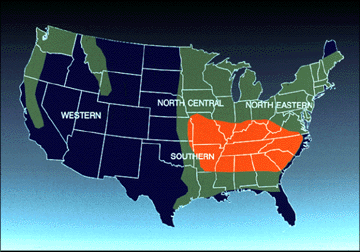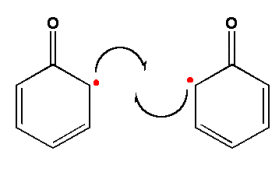
Lecture Twenty-six
Nitrogen Metabolism -- Alkaloids
Goal: Introduce the large, complex group of secondary metabolites of plants, the alkaloids. Give examples of important, representative alkaloid structures and outline their biosynthetic origins. Overview fundamentals of alkaloid biochemistry and give a more in-depth example of the synthesis of an important alkaloid group.
Outline:
- Introduction
- Examples of important, representative alkaloids
- Overview of alkaloid origins
- Principles of alkaloid biochemistry
- A deeper look at the synthesis of selected alkaloids
- Loline alkaloids
Background
a) REQUIRED:
1 - Schardl, C. L., R. B.
Grossman, P. Nagabhyru, J. R. Faulkner and U. P. Mallik. 2007. "Loline
alkaloids: Currencies of mutualism." Phytochemistry 68(7): 980-996.
2 - Chapter 24 sections 24.11 - 24.13 (24.6 - 24.8 old text) of the
Biochemistry & Molecular Biology of Plants class text.
b) SUGGESTED:
1 - Schardl, C. L., D. G. Panaccione
and P. Tudzynski. 2007. Ergot alkaloids -- Biology and molecular biology. The
Alkaloids: Chemistry and Biology 63:
45-86.
2 - Rudgers, J.A., S. Fischer, and K. Clay. 2010. Managing plant symbiosis: fungal endophyte genotype alters plant community composition. Journal of Applied Ecology 47:468-477.
3 - Sato, Fumihiko, Takashi
Hashimoto, Akira Hachiya, Ken-ichi Tamura, Kum-Boo Choi, Takashi Morishige,
Hideki Fujimoto and Yasuyuki Yamada. 2001. Metabolic engineering of plant
alkaloid biosynthesis. PNAS 98:
367-372.
4 - Misako Kato,
Kouichi Mizuno, Alan Crozier, Tatsuhito Fujimura, and Hiroshi Ashihara. 2000.
Caffeine synthase gene from tea leaves. Nature 406: 956-957.
5 - André Kessler
and Ian T. Baldwin. 2002. PLANT RESPONSES TO INSECT HERBIVORY: The Emerging
Molecular Analysis. Annu. Rev. Plant Biol. 53:
299-328.
Biosynthetic relationships of major groups of SECONDARY
COMPOUNDS: ![[major groups of secondary compounds]](secondaryC.gif)
Alkaloids are a class of "secondary" plant metabolites that
traditionally have been classified as basic compounds derived from amino acids
that contain one or more heterocyclic nitrogen atoms. Although this
definition holds for most known alkaloids recently any N containing secondary
compound is considered an alkaloid if it cannot readily be classified otherwise
-- i.e. not an amine, cyanogenic glycoside, glucosinolate, etc. The word
alkaloid is derived from the Arabic al-qali, a plant from which soda was
1st isolated. The original definition for alkaloids is pharmacologically active, N-containing
basic compounds of plant origin. Humans have been using
alkaloids in the form of plant extracts for poisons, narcotics, stimulants and
medicines for at least the past several thousand years. Morphine was
isolated from poppy seeds in 1806 although its structure wasn't known until
1952. The antimalarial properties of quinine, an alkaloid extracted from
the bark of Cinchona spp. trees indigenous to the high eastern slopes of
the
Like many secondary metabolites, plants apparently synthesize alkaloids for defensive purposes. Nicotine and derivatives are among the earliest known and most potent insecticides. Some plant had already evolved the ability to synthesize alkaloids at the beginning of angiosperm evolution ~200 million years ago. Like most natural product chemistry, the accumulation of alkaloids tends to run in families. The plant families with the highest alkaloid levels are the Papaveraceae, Berberidaceae, Leguminosae, Boraginaceae, Apocynaceae, Asclepiadaceae, Liliaceae, Gnetaceae, Ranunculaceae, Rubiaceae, Solanaceae and Rutaceae.
Most alkaloid skeletons are derived from amino acids with many different amino acids being alkaloid biosynthetic precursors. Some alkaloid carbon skeletons are derived from other groups of molecules such as the steroid alkaloids with the nitrogen from glutamine or another N donor being added in later biosynthetic steps. Alkaloids are classified based on the structure of the N-heterocycle. Some major alkaloids and their structures are given in Kutchan (1995; The Plant Cell 7:1059-1070).
In this class we will cover a few of the alkaloid groups, some representative structures and some examples of biosyntheses.
Examples of Important Representative Alkaloids and Outline of their Biosynthetic Origins
Cocaine is an example of a tropane-type of pyrrolidine alkaloid in which the N-heterocycle is derived from L-ornithine, an amino acid derived from glutamate. Tropane has a distinctive 3 dimensional structure:
![[tropane-type of pyrrolidine alkaloid]](tropane.gif)
The piperidine group of alkaloids is derived from L-lysine. The heterocycle structure is:
![[piperidine alkaloid]](piperidine.gif)
The pyridine alkaloids are derived from aspartate or phenylalanine. Nicotine is an example of a pyridine alkaloid.
![[pyridine alkaloid]](pyridine.gif)
Quinoline alkaloids such as quinine can be derived from L-tryptophan:
![[Quinoline alkaloid]](quinoline.gif)
Isoquinoline alkaloids, which have an N-heterocycle isomeric to quinoline, can be derived from tyrosine. Morphine is an isoquinoline alkaloid:
![[Isoquinoline alkaloid]](isoquinoline.gif)
Indole alkaloids contain an indole ring derived from L-tryptophan. The active principle of the ergot fungus, agroclavine, is an indole alkaloid.
![[Indole alkaloid]](indole.gif)
Purine alkaloids, such as caffeine and theobromine, are purine derivatives so they are derived from aspartate, glycine and glutamine. Caffeine is a central stimulant, it can be used clinically as a cardiac and respiratory stimulant and as a diuretic. Being a DNA base analog, it also has mutagenic properties. Theobromine, the principal alkaloid of cacao beans (1-3% of seed weight), is a diuretic, smooth muscle relaxant, cardiac stimulant and vasodilator like the atropine-containing extract from Egyptian henbane used by Cleopatra. These are among the simplest alkaloids:
![[Caffeine alkaloid]](caffeine.gif)
See simplified version from Juan Pan:
![[caffeine synthesis]](caffsyn.jpg)
Taxol (paclitaxel), an effective antitumor compound, is an example of a steroid alkaloid (Fig. 1 of Kutchan, 1995; The Plant Cell 7:1059-1070; Fig 24.17 class text).
Principles of Alkaloid Biochemistry
There are 3 important reactions that occur many times in alkaloid biosynthetic reactions, the oxidative coupling of phenols, Mannich-type reactions and Schiff base formation. Oxidative coupling of phenols involves hydrogen removal from the hydroxy group by one electron transfer oxidizing agents such as ferric chloride creating a highly reactive phenolate free radical. These phenolate radicals readily undergo coupling (dimerization) reactions:
The Mannich reaction involves a carbonyl compound (usually an aldehyde), an amine and a compound that can provide a carbanion such as by loss of an acidic hydrogen followed by condensation of these 3 reactants:
![[Mannich Reaction]](MannichRx.gif)
Compounds with primary amino groups can react with carbonyl groups to form Schiff bases or azomethines the product being an imine:
![[Formation of Schiff bases]](imine.gif)
A Deeper Look at the Synthesis of Selected Alkaloids(see also Juan Pan's presentation on alkaloid metabolic engineering for further info.)
Only 3 relatively simple pathways of alkaloid biosynthetic routes that include the synthesis of other important biochemical precursors will be covered.
The formation of isoquinoline alkaloids can be illustrated by biosynthesis of peyote alkaloids by the peyote cactus involving at least 7 steps. The principal biosynthetic precursor is tyrosine, which is hydroxylated to dihydroxyphenylalanine (DOPA) which is decarboxylated to dopamine. One of the hydroxyl groups of dopamine is methylated, another hydroxyl added and a 2nd hydroxyl group methylated forming 3-hydroxy-4, 5-dimethoxyphenylethylamine. This condenses with glyoxylate forming peyoxylic acid that can be converted into various other peyote alkaloids:
![[peyote alkaloid synthesis]](peyote.gif)
One of the most important alkaloid precursors is the benzylisoquinoline alkaloid (S)-reticuline formed from 2L-Tyr precursors as described in Fig. 24.37 of the class text.
(S)-reticuline is a precursor of a large number of surprisingly diverse tetrahydrobenzylisoquinoline alkaloids depending on how this molecule is twisted and turned prior to various enzymatic oxidation reactions (Fig. 24.38).
The biosynthesis of serotonin involves hydroxylation and decarboxylation of L-tryptophan. Decarboxylation of tryptophan alone yields tryptamine, an important protoalkaloid:
An interesting aspect of alkaloids and
plant biology is the accumulation of certain alkaloids in fungal/cool season
grass mutualistic relationships. This mutualism can increase the ecological
fitness of the host plant such as increased plant growth and seed production
and increased insect and drought resistance. Much of the most widely
planted crop plant in

Host fitness....................Symbiont fitness
Mutualism .................+..................................... +
Antagonism ................- ......................................+
Commensalism ..........0 ......................................+
The general structure of a loline alkaloid is:
![[loline alkaloid structure]](loline.gif)
R1=H and R2=CH3 for loline and R1 and R2=H for norloline.
Ergot Alkaloids
Alkaloids and other secondary compounds can be constitutive or inducible. Jasmonic acid (and some derivatives) is a major signal for induction of alkaloids and other secondary molecules in plants.
|
All materials © 2016 David Hildebrand, unless otherwise noted. |
|||||||
Please e-mail us if you
have any questions or comments regarding the class or the webpages.
This page was last modified March 1, 2016.



